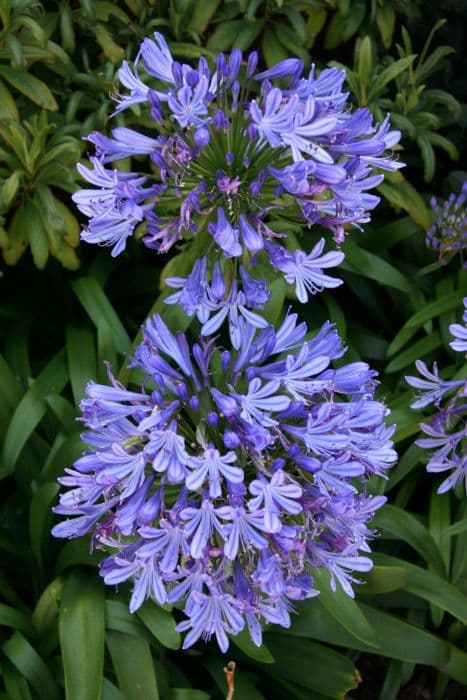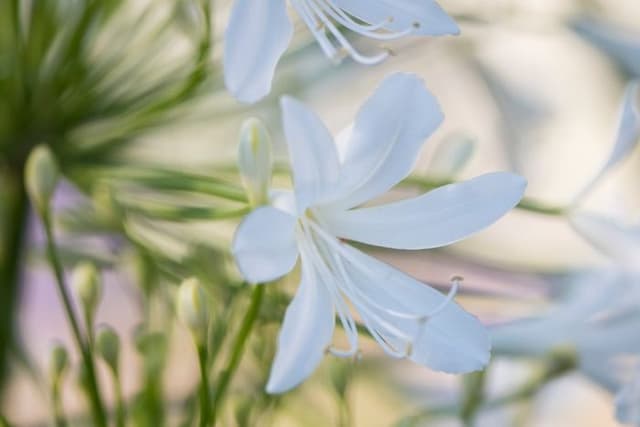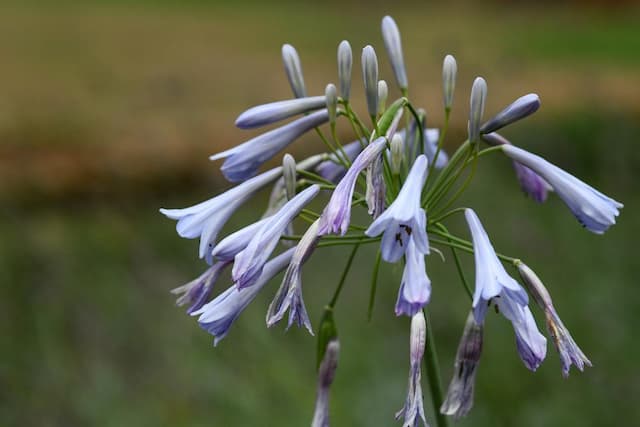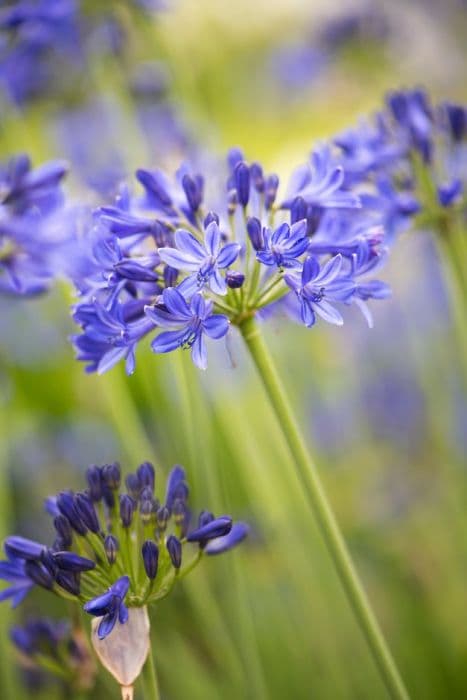Lily of the Nile Agapanthus 'Tinkerbell' (v)

ABOUT
Agapanthus 'Tinkerbell' features a striking appearance that draws attention in the garden. It bears lush, strap-like leaves that are distinctively variegated, edged in creamy white or soft yellow which creates an eye-catching contrast with the green center. During its blooming period, it produces rounded clusters of trumpet-shaped flowers that perch atop stiff, upright stems. The blossoms are typically a deep blue or violet shade, adding a pop of color against the variegated foliage. The leaves emanate from a central base, creating a fountain-like effect that enhances the plant's overall texture and form. Though compact, 'Tinkerbell' is a lush plant that radiates with both its foliage and its charming floral display. The combination of variegated leaves and vibrant flowers makes it a desirable addition to borders, containers, or as an accent plant in garden arrangements.
About this plant
 Names
NamesFamily
Amaryllidaceae.
Synonyms
Variegated Lily of the Nile, Dwarf Variegated Agapanthus, Tinkerbell Agapanthus.
Common names
Agapanthus 'Tinkerbell' (v)
 Toxicity
ToxicityTo humans
The Agapanthus 'Tinkerbell,' commonly known as Lily of the Nile, contains compounds that can be toxic to humans when ingested. While it is primarily an ornamental plant and not typically consumed, if parts of the plant are eaten, they can cause symptoms such as nausea, vomiting, and diarrhea. In some cases, large ingestions might lead to more severe reactions, including difficulty swallowing, inflammation of the throat, and abdominal pain. It's important to handle the plant with care and ensure that it is not consumed by children, who might be drawn to its attractive flowers.
To pets
The Agapanthus 'Tinkerbell,' commonly known as Lily of the Nile, is considered toxic to both dogs and cats. If pets consume parts of the plant, they might experience symptoms such as nausea, vomiting, and diarrhea. More serious effects like tremors or cardiac issues can occur with significant ingestions. It's advisable to keep this plant out of reach of pets and to seek veterinary attention if there are signs that they have consumed any part of it.
 Characteristics
CharacteristicsLife cycle
Perennials
Foliage type
Evergreen
Color of leaves
Variegated
Flower color
Blue
Height
1-2 feet (30-60 cm)
Spread
1-2 feet (30-60 cm)
Plant type
Herb
Hardiness zones
8
Native area
South Africa
Benefits
 General Benefits
General Benefits- Ornamental Value: Agapanthus 'Tinkerbell' (or Lily of the Nile) bears attractive variegated foliage and striking blue or white flowers that enhance the visual appeal of gardens and landscapes.
- Drought Tolerance: Once established, the Lily of the Nile is drought-resistant, making it suitable for gardens in arid climates or for gardeners seeking low-water-use plants.
- Ease of Care: This plant is relatively low-maintenance, requiring minimal attention once it has settled into its growing conditions.
- Long Blooming Period: The Lily of the Nile typically has a long flowering season, providing color and interest in the garden throughout the summer months.
- Attracts Pollinators: Blossoms of the Agapanthus 'Tinkerbell' attract bees, butterflies, and other beneficial pollinators, supporting local ecosystems.
- Versatility in Landscaping: This variety of Agapanthus can be used in a range of landscaping designs, including borders, containers, and as a focal point in garden beds.
- Perennial Growth: As a perennial, the Lily of the Nile will return year after year, providing lasting value and reducing the need for annual replanting.
- Coastal Tolerance: Agapanthus 'Tinkerbell' is tolerant of coastal conditions, such as salt spray, making it ideal for seaside gardens.
- Deer Resistance: Often, deer do not prefer to eat Agapanthus, making it a good option for gardens in areas with a deer population.
 Medical Properties
Medical PropertiesThis plant is not used for medical purposes.
 Air-purifying Qualities
Air-purifying QualitiesThis plant is not specifically known for air purifying qualities.
 Other Uses
Other Uses- Agapanthus 'Tinkerbell' can be used as a natural dye source, where its flowers are processed to extract pigments that can color fabrics and artworks.
- The sturdy foliage of Agapanthus can be woven into garden baskets or mats, offering a sustainable crafting material.
- The long, firm stems of the plant make for excellent natural supports in the garden for other, less sturdy plants.
- Agapanthus can be used in educational settings to teach botany and horticulture, particularly focusing on bulbous plant growth and care.
- The plant's seed pods can be dried and used in floral arrangements or as natural decor, adding texture and interest.
- The flowers of the Agapanthus may be used in the preparation of natural confetti for eco-friendly celebrations.
- In photography, the unique form and color of Agapanthus 'Tinkerbell' make it a captivating subject for botanical photography and art projects.
- As a garden plant, Agapanthus serves as a living mulch, covering the soil and helping to retain soil moisture and suppress weeds.
- The fibrous roots of the plant can be studied for their soil-binding properties, contributing to erosion control research.
- The Agapanthus 'Tinkerbell' acts as a natural indicator of soil pH; gardeners observe the color of its flowers, which can vary with the acidity or alkalinity of the soil.
Interesting Facts
 Feng Shui
Feng ShuiThe plant Agapanthus is not used in Feng Shui practice.
 Zodiac Sign Compitability
Zodiac Sign CompitabilityThe plant Agapanthus is not used in astrology practice.
 Plant Symbolism
Plant Symbolism- Love Letters: Agapanthus, commonly known as Lily of the Nile, often symbolizes love and adoration. The 'Tinkerbell' variety would thus be associated with affectionate communication or a message from someone who holds deep affection.
- Beauty: With its striking flowers, the Lily of the Nile is representative of beauty and elegance, indicating the 'Tinkerbell' variety could symbolize an appreciation for the beautiful things in life.
- Strength: This plant is known for its hardiness and ability to thrive under tough conditions. The 'Tinkerbell' name could therefore symbolize resilience and strength, conveying a message of endurance through hardships.
- Loneliness or Solitude: Given its origin as a plant that stands tall and often grows apart from others, the Lily of the Nile can also represent feelings of solitude or the state of being alone yet not necessarily lonely.
- Peace: Its calming blue color is often associated with tranquility and peace, suggesting that the 'Tinkerbell' variety may embody these serene qualities.
 Water
WaterAfrican Lily 'Tinkerbell' should be watered deeply to ensure the roots receive moisture, but allowing the soil to dry between waterings to prevent root rot. Typically, you should provide about 1 to 1.5 gallons of water per plant every week during the growing season, reducing frequency in the winter when the plant is dormant. In hotter, drier climates, watering may be needed twice a week, while in cooler, wetter regions, once a week may suffice. Always check the soil moisture before watering to adjust the amount and frequency accordingly.
 Light
LightThe African Lily 'Tinkerbell' thrives best in full sun to partial shade conditions. It should be placed in a spot where it can receive at least six hours of sunlight daily. While the plant can tolerate partial shade, too much shade can lead to fewer blooms. The optimal spot would be one that gets morning sun and afternoon dappled light, which encourages robust growth and flowering.
 Temperature
TemperatureAfrican Lily 'Tinkerbell' prefers a temperate climate with temperatures ranging between 50 and 80 degrees Fahrenheit for optimal growth. They can survive minimum temperatures down to about 20 degrees Fahrenheit, but frost can damage the foliage and flowers. The ideal temperature range for these plants is typically between 60 and 70 degrees Fahrenheit during the day.
 Pruning
PruningPrune African Lily 'Tinkerbell' to remove spent flower stems and dead foliage, and to maintain its attractive shape. Pruning is often done after the plant has finished flowering, generally in late summer or early fall. This not only tidies up the plant but also encourages new growth. Division of clumps can occur every three to four years for plant rejuvenation.
 Cleaning
CleaningAs needed
 Soil
SoilLily of the Nile 'Tinkerbell' prefers well-draining soil that's rich in organic matter. A mixture of two parts loam to one part peat or compost, with perlite for improved drainage, works well. This plant thrives in a soil pH of 6.0 to 7.0.
 Repotting
RepottingLily of the Nile 'Tinkerbell' should generally be repotted every 2 to 3 years to refresh the soil and accommodate root growth. If growth slows significantly, consider checking for crowding and repot as needed.
 Humidity & Misting
Humidity & MistingLily of the Nile 'Tinkerbell' is adaptable to a range of humidity levels typical of most home environments and does not require any special humidity considerations.
 Suitable locations
Suitable locationsIndoor
Provide bright light and consistent watering.
Outdoor
Plant in sun to part shade and water regularly.
Hardiness zone
9-11 USDA
 Life cycle
Life cycleAgapanthus 'Tinkerbell', commonly known as Variegated Lily of the Nile, begins its life cycle as a seed, which when sown in well-draining soil and given proper warmth and moisture, will germinate. As a seedling, it prioritizes root development and the emergence of its distinctive variegated foliage. The plant enters a vegetative growth phase where it focuses on developing a strong, fleshy root system and long, strap-like leaves with creamy margins and green centers. After reaching maturity, which can take several years, it produces tall flower stalks topped with clusters of bell-shaped flowers during the summer months. Once pollinated, these flowers produce seed capsules, which upon ripening, open to release seeds, thereby allowing the life cycle to begin anew. During its life span, the plant may also propagate vegetatively by division of the root clump, enabling gardeners to cultivate new plants from a single, mature individual.
 Propogation
PropogationPropogation time
Spring-Early Summer
Agapanthus 'Tinkerbell', commonly known as the variegated Lily of the Nile, is typically propagated in the spring or early summer, when the plant's growth is most active. The most popular method of propagation for this plant is division. This involves carefully lifting the plant and separating the clump into smaller sections, ensuring that each section has at least one or two growing points or shoots. These sections can then be replanted into well-draining soil, ideally with the crown set at about the same level it was growing at previously, and watered in well. This method allows for a rapid increase in the number of plants and is relatively straightforward, even for novice gardeners.








![African lily [Brilliant Blue]](/_next/image?url=https%3A%2F%2Fplants-admin.emdemapps.com%2Fimages%2Fplants%2F%2Fimages%2F604b5e3c28e2b.png&w=640&q=75)
